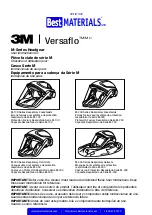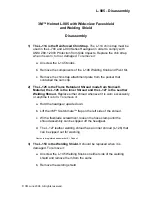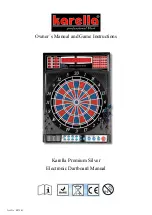
Warn all personnel to keep clear of CONVEYOR during unit start-up
9
START-UP PROCEDURES
DRIVE CHAIN AND SPROCKET ALIGNMENT
DRIVE CHAIN AND SPROCKET TENSION
Maintaining proper chain tension is especially important. Again, a peri-
odic visual inspection is recommended to ensure chain tension within a
pre-determined operating range.
Remember, before any adjustments are attempted, conveyor must be
shut “OFF” and power source locked out.
Before replacing chain guard cover, check to see if drive chain is operat-
ing within 1/2” range (see illustration). If unit is out of tolerance, adjust-
ment is necessary.
To adjust drive chain tension, tensioner bolt located on reducer push
plate should be tightened (rotate clockwise) if chain tension
is loose. Tighten until proper operating range is achieved. If chain
tension is too tight, loosen tensioner bolt (rotate counterclockwise) as
required. When adjustment is complete replace chain guard cover.
WARNING: Do not operate unit until chain guard cover is replaced.
Serious operator or other personal injury could result if protective
guarding is not replaced.
Set up and maintenance of drive sprocket and drive chain alignment is
critical. A periodic visual inspection is recommended to confirm align-
ment of drive components (which includes both drive sprockets and drive
chain). Should set screws become loose, drive sprockets are subject to
excessive wear and ultimately, to untimely replacement.
To check drive sprocket alignment, it is imperative that conveyor is
shut “OFF” and power source is locked out before any adjustments are
attempted.
Remove chain guard cover and place straight-edge (see illus-
tration) across face of both drive sprockets. If re-alignment is necessary,
loosen set screws and adjust drive sprockets as required. Remember to
securely tighten set screws when alignment is complete. Before replacing
chain guard cover, check drive chain tension as described in following
section, “Drive Chain and Sprocket Tension.”
Do not operate without guards in place.
GEAR REDUCER WITH POSIVENT
PosiVent Unique design incorporates
a single seam construction. Factory
filled with synthetic lubrication for
universal mounting. Lubed for life, no
oil changes are required.
No vent plug required.
PREPARING FOR INITIAL START-UP
Provisions must be in order to instruct all personnel coming in contact
with conveyor on the location of emergency stops,
pull cords, etc.
A routine maintenance program should be implemented before unit is
placed into operation so that fundamental unit components are attended
to. This maintenance program should include an inspection to ensure
that any dangerous or hazardous operating conditions are noted and
IMMEDIATELy corrected, as well as including electrical and mechanical
unit inspections and corrections.
Finally, when conveyor is initially started, an immediate visual inspection
should include motor, gear reducer, belt tracking (discussed in following
section under “Belt Tracking”) and related adjustments noted in handbook
ELECTRICAL CONTROLS
Electrical controls must be designed by
a qualified electrical engineer to ensure
that appropriate safety features (emer-
gency stops, pull cords, switches, etc.)
are installed on unit for safe operation.
Summary of Contents for 450BOS
Page 1: ...Installing and Maintaining Your Roach Conveyor...
Page 17: ...MODEL 725TB END DRIVE END side mount DRIVE center drive drawings 17...
Page 26: ...MODEL 796RB END DRIVE END side mount DRIVE center drive drawings 26...
Page 29: ...MODEL 751RB END DRIVE END side mount DRIVE center drive drawings 29...










































